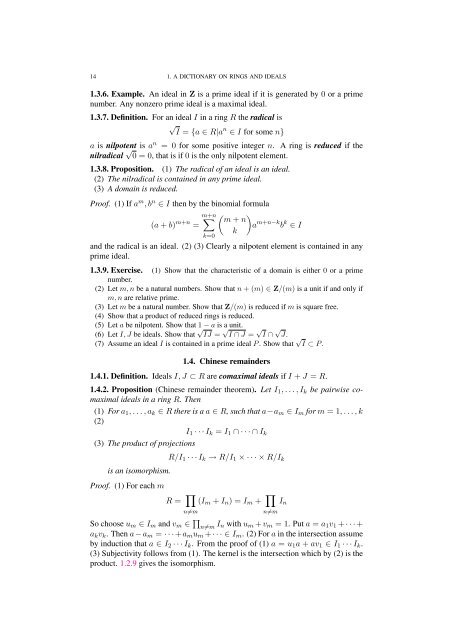Commutative algebra - Department of Mathematical Sciences - old ...
Commutative algebra - Department of Mathematical Sciences - old ...
Commutative algebra - Department of Mathematical Sciences - old ...
Create successful ePaper yourself
Turn your PDF publications into a flip-book with our unique Google optimized e-Paper software.
14 1. A DICTIONARY ON RINGS AND IDEALS<br />
1.3.6. Example. An ideal in Z is a prime ideal if it is generated by 0 or a prime<br />
number. Any nonzero prime ideal is a maximal ideal.<br />
1.3.7. Definition. For an ideal I in a ring R the radical is<br />
√ I = {a ∈ R|a n ∈ I for some n}<br />
a is nilpotent is a n = 0 for some positive integer n. A ring is reduced if the<br />
nilradical √ 0 = 0, that is if 0 is the only nilpotent element.<br />
1.3.8. Proposition. (1) The radical <strong>of</strong> an ideal is an ideal.<br />
(2) The nilradical is contained in any prime ideal.<br />
(3) A domain is reduced.<br />
Pro<strong>of</strong>. (1) If am , bn ∈ I then by the binomial formula<br />
(a + b) m+n m+n <br />
<br />
m + n<br />
=<br />
a<br />
k<br />
m+n−k b k ∈ I<br />
k=0<br />
and the radical is an ideal. (2) (3) Clearly a nilpotent element is contained in any<br />
prime ideal.<br />
1.3.9. Exercise. (1) Show that the characteristic <strong>of</strong> a domain is either 0 or a prime<br />
number.<br />
(2) Let m, n be a natural numbers. Show that n + (m) ∈ Z/(m) is a unit if and only if<br />
m, n are relative prime.<br />
(3) Let m be a natural number. Show that Z/(m) is reduced if m is square free.<br />
(4) Show that a product <strong>of</strong> reduced rings is reduced.<br />
(5) Let a be nilpotent. Show that 1 − a is a unit.<br />
(6) Let I, J be ideals. Show that √ IJ = √ I ∩ J = √ I ∩ √ J.<br />
(7) Assume an ideal I is contained in a prime ideal P . Show that √ I ⊂ P .<br />
1.4. Chinese remainders<br />
1.4.1. Definition. Ideals I, J ⊂ R are comaximal ideals if I + J = R.<br />
1.4.2. Proposition (Chinese remainder theorem). Let I1, . . . , Ik be pairwise comaximal<br />
ideals in a ring R. Then<br />
(1) For a1, . . . , ak ∈ R there is a a ∈ R, such that a−am ∈ Im for m = 1, . . . , k<br />
(2)<br />
(3) The product <strong>of</strong> projections<br />
is an isomorphism.<br />
Pro<strong>of</strong>. (1) For each m<br />
I1 · · · Ik = I1 ∩ · · · ∩ Ik<br />
R/I1 · · · Ik → R/I1 × · · · × R/Ik<br />
R = <br />
(Im + In) = Im + <br />
n=m<br />
n=m<br />
So choose um ∈ Im and vm ∈ <br />
n=m In with um + vm = 1. Put a = a1v1 + · · · +<br />
akvk. Then a − am = · · · + amum + · · · ∈ Im. (2) For a in the intersection assume<br />
by induction that a ∈ I2 · · · Ik. From the pro<strong>of</strong> <strong>of</strong> (1) a = u1a + av1 ∈ I1 · · · Ik.<br />
(3) Subjectivity follows from (1). The kernel is the intersection which by (2) is the<br />
product. 1.2.9 gives the isomorphism.<br />
In
















